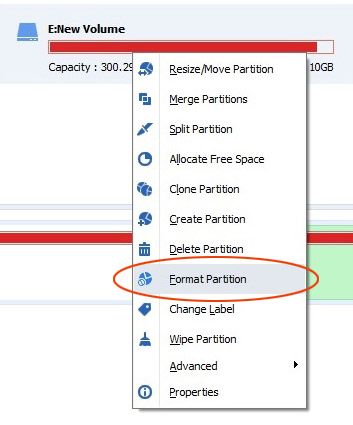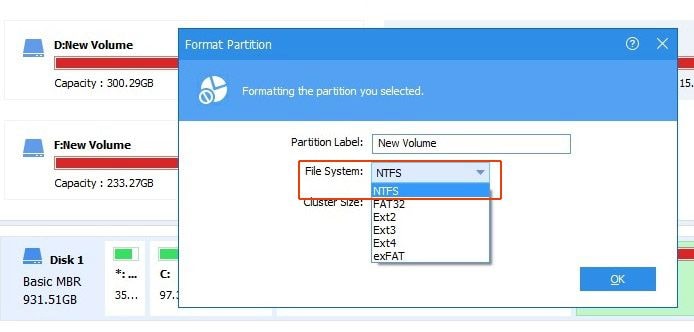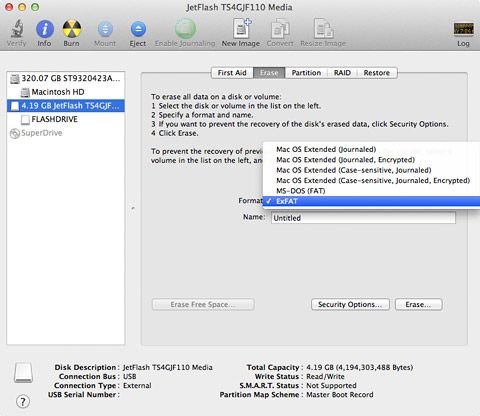4 Quick Ways to Convert FAT32 to exFAT on Windows Mac Linux
"exFAT" file system is the latest file system that has been launched and many people are looking to convert from the "FAT32" to the "exFAT" file system. This article is for those looking to convert their file systems.
This article gives a brief detail on the difference between the "FAT32" and "exFAT" file systems, different ways to format "FAT32" to "exFAT" on Windows which include using file explorer, disk management, command prompt, and AOMEI partition assistant tool. In addition to this, you can also see some bonus tips to be followed while formatting the partitions.
Part 1: "FAT32" vs. "exFAT": What's the Difference and Which One Is Better?
"FAT32" (File Allocation Table) is the most popular file system as it is the oldest and is used by almost every Operating system. But, "exFAT" is the latest file system which is widely used in formatting external and USB drives. Let us understand which one is better by comparing the following
| Feature |
"FAT32" |
"exFAT" |
| Devices Supported |
Compatible on any Operating system, video game consoles, media players, Android USB expansions, and many other devices |
"exFAT" is also compatible on all types of devices as "FAT32" but it might not work for some media players and Android devices |
| Sizes Supported |
Supports the files which are up to a max of 4GB in size. |
There is no limit for any file sizes. So it is widely used to store large-sized files. |
| Speed |
When compared to "exFAT", "FAT32" is slow in writing and reading data |
"exFAT" is faster than "FAT32" in writing and reading the data |
Based on the above table, it is proven that the "exFAT" file system is far better than the "FAT32" file system when you have files with large sizes and need effective and efficient formatting.
Part 2: How to Format "FAT32" to "exFAT" on Windows?
Way 1. Format "FAT32" to "exFAT" in File Explorer
Using File Explorer, you can format the flash drive from "FAT32" to "exFAT" easily and effectively following the below steps:
Step 1: Open File Explorer by pressing "Windows" + "E" keys.
Step 2: In the explorer look for your USB flash drive and right-click on it.
Step 3: Click on "Format" and select "exFAT" from the "File System" list.
Step 4: Click the "Start" button in the end.

Way 2: Convert "FAT32" to "exFAT" using CMD
You can convert "FAT32" to "exFAT" using a CMD prompt if you know the commands to perform the Diskpart. To use this Diskpart tool, you need to follow the below steps:
Step 1: Open Run dialog box and type "diskpart " to the run the Diskpart.
Step 2: Type the following command and press enter after every command:
- "list disk"
- "select disk n"
- "list partition"
- "select partition m"
- "format fs = "exFAT""
From above n = no of external drives, m = no of external drive partitions.

Step 3: Once all the above commands are executed, the formatting progress will be completed within a short time.
Way 3: Convert "FAT32" to "exFAT" with Windows Disk Management
Windows Disk Management is an effective built-in feature provided by Windows which helps you in managing the hard disk partitions without any difficulties or errors. It might not be an effective solution when compared to other third-party tools but it is enough to convert "FAT32" to "exFAT". For this follow the below steps:
Step 1: Open "Disk Management" by right-clicking on the Windows start menu.
Step 2: Select the "FAT32" formatted partition, right-click on it and click on "Format".

Step 3: In the format page, change the "file system" to "exFAT" from "FAT32" and click on "Ok".
Step 4: Now the formatting process will start and you may lose all your data so make sure that the important data is taken as a backup.
Step 5: Once the formatting is done, you can see that "FAT32" is converted to "exFAT" in the disk management interface.
Way 4: Format "FAT32" to "exFAT" through a third-party converter
Generally, the above-mentioned methods may or may not work as they may face issues like write-protection, file system corruption, etc. In such cases, third-party tools like the AOMEI partition assistant can give better results in formatting the "FAT32" to the "exFAT" file system. Follow the below steps for using the AOMEI partition assistant tool.
An important point to note is to take a backup of all the important files and data because once the formatting has been started, you may lose all your data and it will be difficult to retrieve the data.
Follow the below steps for using the AOMEI partition assistant tool.
Step 1: Launch AOMEI
Download, install, and double click on the AOMEI icon to launch the AOMEI partition assistant tool.
Step 2: Format Partition
In the interface, choose the drive that you wish to format and right-click on it. In the menu displayed, click on "Format Partition".

Step 3: Choose "exFAT"
In the "Format Partition" interface, select "exFAT" from the file system menu. "Partition Label" and "Cluster Size" can be added as per the need. Click on "Ok" and "Apply" to perform the formatting.

Following the above-mentioned steps, you can format your disk partition or drive from "FAT32" to "exFAT" easily and effectively.
Part 3: Bonus Tips to Convert "FAT32" to NTFS on Mac and Linux
1. Convert "FAT32" to "exFAT" on Mac
You can easily convert a "FAT32" file system to "exFAT" using the "Disk Utility" option on Mac. Follow the below steps for the following:
Step 1: Go to "Applications"->" Utilities" and launch "Disk Utility".
Step 2: In the Disk Utility interface, select the external drive that you want to format.
Step 3: Under the "Erase" tab, select the "exFAT" file type from the menu list.
Step 4: Click on the "Erase" button to start the formatting from "FAT32" to "exFAT".

2. Format "FAT32" to "exFAT" on Linux
To format "FAT32" to "exFAT" file system on Linux, follow the below steps:
Step 1: To view all the drives attached to your system, type sudo fdisk -l in the command line.
Step 2: Select the drive that you want to format and type sudo wipefs -a /dev/sdb to start fresh with a new "exFAT" file system
Step 3: Follow the on-screen instructions and select "exFAT" from the message "HPFS/NTFS/exFAT" it displays

Step 4: Press "w" to sync the disk partitions.
Step 5: Type sudo mkfs."exFAT" -n hardDisk /dev/sdb1 to format your drive to "exFAT"
Read More: Format a Hard Drive Disk Partition in Linux | Detailed Guide
The Bottom Line
As mentioned in the article, different ways can be used to convert or format from the "FAT32" to the "exFAT" file system. Follow all the above-mentioned procedures to easily and effectively format your drive.
While formatting your drive using file explorer, command prompt, or disk management, you may find some trouble because of the issues like write-protection, file system corruption, etc. So, it is recommended to use the "AOMEI Partition Assistant" a third party tool which provides an interactive and easy to use interface to format effectively without any interruptions.
People Also Ask
-
Which is better "FAT32" or "exFAT"?
When compared to "FAT32", "exFAT" is a better file system type in the following aspects:
- There is no file size limit for "exFAT", but "FAT32" can support up to a size of 4GB only.
- "exFAT" file system performs faster writing and reading of data when compared to "FAT32".
-
How do I convert "FAT32" to "exFAT" on Mac?
You can convert "FAT32" to "exFAT" on Mac using the Disk utility option that it provides. In the disk utility, follow the below steps:
- Select the disk partition that you want to format from the list of disks displayed on the left pane of the interface.
- Under erase tab->File system, select "exFAT" and click on erase.
This will format your partition completely with file type as "exFAT".
-
How do I convert my flash drive from "exFAT" to "FAT32"?
Converting your flash drive from "exFAT" to "FAT32" has become very easy now. Follow the below steps to format:
- Double-click on "This PC" and from the list of drives select the flash drive.
- Right-click on the flash drive and click "Format".
- In the Format window, select the "file type" as "FAT32".
- Click on Format.
Partition Recovery
- Partition Management
- Solve Partition Problems
- Partition Tips









 ChatGPT
ChatGPT
 Perplexity
Perplexity
 Google AI Mode
Google AI Mode
 Grok
Grok
























Theo Lucia
chief Editor